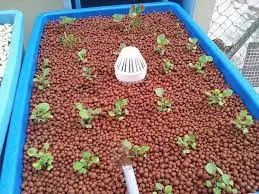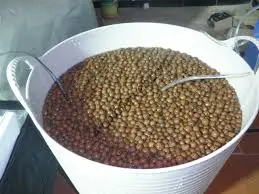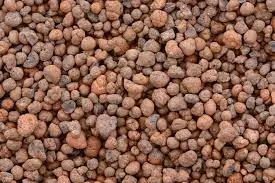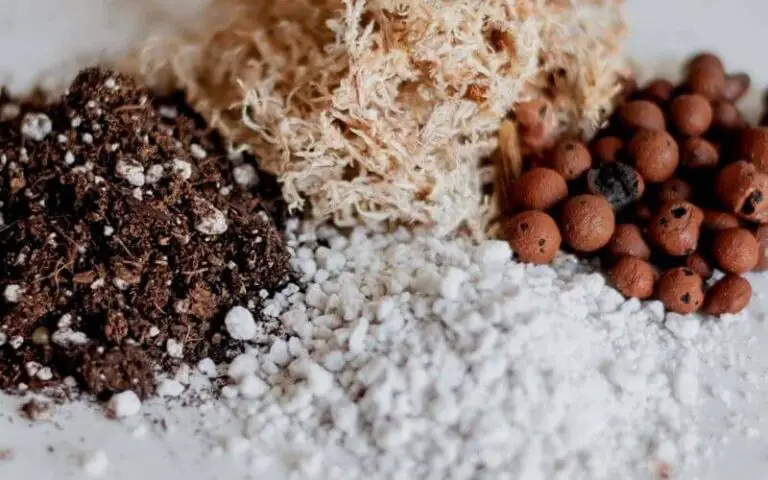Hydroton (Expanded Clay Pebbles) Growing Guide
Table of Contents
Benefits of Using Hydroton in Hydroponic Systems
Hydroton, also known as expanded clay pebbles, is a popular growing medium in hydroponic systems due to its numerous benefits. One of the key advantages of using Hydroton is its excellent aeration properties, allowing for optimal oxygenation of plant roots. This aeration helps prevent overwatering and root rot, fostering healthier root systems and improving overall plant growth and productivity. Additionally, Hydroton is lightweight and inert, making it easy to work with and resistant to mold and pests, providing a clean and stable growing environment for plants.
Moreover, Hydroton offers great water retention capabilities, ensuring that plant roots receive consistent moisture levels without becoming waterlogged. This not only reduces the risk of nutrient deficiencies but also helps maintain proper hydration for plants, promoting robust growth and development. With its reusable nature and sustainability, Hydroton proves to be a cost-effective and eco-friendly choice for hydroponic enthusiasts looking to optimize their growing systems for maximum yield and plant health.

Choosing the Right Size of Hydroton for Your Plants
When selecting the right size of Hydroton for your plants in a hydroponic system, it is crucial to consider the specific needs of the plants you are growing. Smaller Hydroton pellets are typically preferred for smaller plants or those with delicate root systems, as they provide better aeration and drainage. Larger plants with more extensive root systems may benefit from larger Hydroton pellets, which can offer increased stability and support.
It is important to match the size of the Hydroton to the size of the plant roots to ensure optimal growth and development. By choosing the appropriate size of Hydroton, you can create an ideal growing environment that supports healthy root growth and overall plant vigor. Experimenting with different sizes of Hydroton and observing the results can help you determine the best fit for your specific plants and hydroponic setup.
When selecting the right size of Hydroton (clay pebbles) for your plants in a hydroponic system, the following factors are considered:
| Factor | Description |
| Net Pot Size | Net pots hold the growing medium in your hydroponic system. They range from 2 inches to 6 inches in diameter. The correct size depends on the plant you’re growing and the type of hydroponic system. Commercial kits often specify a particular size, while homemade systems offer more flexibility. |
| Root Accessibility | Net pots allow roots to access the nutrient solution. The net holds the core root mass, while finer roots spread beyond the pot. Depending on the hydroponic system, secondary roots either float freely in the solution or receive periodic treatments. The net supports the plant’s weight while allowing root access to nutrients below. |
| Importance of Size | Choosing the right size is crucial. A pot too small cramps the plant, while one too large wastes energy. It also needs to fit your system. Commercial setups require precise sizing, while homemade rigs can be more flexible. |
| Available Sizes | Net pots are measured by diameter (in inches). Common sizes include: 2″: Ideal for herbs and lettuces. 3″ to 4″: Suitable for most plants. 6”: Used for larger plants. |
| Mesh Size | The mesh size affects drainage and root penetration. Finer mesh retains more growing medium, while coarser mesh allows better drainage. |
| Lip Size | The lip around the net pot matters. A wider lip provides stability and prevents tipping. |
| Type of Net | Consider the material (plastic or mesh) and durability when choosing net pots for your hydroponic kit. |
Preparing Hydroton Before Using in Your Hydroponic System
When preparing Hydroton for use in your hydroponic system, it is essential to follow proper steps to ensure optimal plant growth. Begin by thoroughly rinsing the Hydroton under running water to remove any dust or debris. This will help prevent clogging in the system and provide a clean environment for your plants’ roots to thrive. Once rinsed, soak the Hydroton in water for at least 24 hours to ensure it is fully saturated and ready to support plant growth effectively.
After soaking, it is important to drain excess water from the Hydroton to prevent over-saturation in your hydroponic system. By ensuring the Hydroton is properly prepared and hydrated before use, you can create an ideal growing environment for your plants to flourish and thrive. Properly preparing your Hydroton sets the foundation for a successful hydroponic setup, promoting healthy roots and robust plant growth.
Here’s a step-by-step guide on how to prepare Hydroton (expanded clay pebbles) before using them in your hydroponic system:
| Step | Action |
| 1 | Rinse the Pebbles: Before using Hydroton, rinse the pebbles thoroughly to remove any dust or debris. Skipping this step could lead to issues later on, so take the time to do it properly from the start. |
| 2 | Soak the Pebbles: After rinsing, soak the pebbles for at least six hours, or even better, up to 24 hours. This ensures they are fully saturated with water and ready for use. |
| 3 | Check Water Quality: Before adding Hydroton to your hydroponic system, check the pH and parts per million (ppm) of your water. Adjust the pH to the range of 5.5 to 6.5 using pH up or pH down solutions. |
| 4 | Fill Reservoirs or Net Pots: Use the fully soaked clay pebbles to fill reservoirs or net pots in your hydroponic setup. They provide excellent aeration and support for plant roots. |
Understanding the pH Level Requirements for Hydroton
Hydroton, a popular growing medium in hydroponic systems, requires careful attention to pH levels for optimal plant growth. Maintaining the correct pH range is crucial to ensure that essential nutrients are available to plants and that they can be effectively absorbed.
The ideal pH range for Hydroton is between 5.5 and 6.5, slightly acidic to neutral. Monitoring and adjusting the pH of the nutrient solution is essential to prevent nutrient deficiencies or toxicities that can hinder plant growth. It is recommended to use a pH meter or pH test kit to regularly check and adjust the pH levels to create the best growing environment for your plants.
How to Properly Rinse Hydroton Before Use
Rinsing hydroton before use is a crucial step in preparing this growing medium for your hydroponic system. Hydroton is a type of expanded clay pebbles that can contain dust and debris from production, which can affect the pH and nutrient levels of your hydroponic solution. To properly rinse hydroton, you’ll need to place the pebbles in a bucket or container and rinse them thoroughly with water. It’s essential to rinse until the water runs clear to ensure that all impurities are removed.
Once you have rinsed the hydroton, you can soak the pebbles in pH-balanced water for a few hours before using them in your hydroponic system. This soaking process helps to stabilize the pH levels of the hydroton and ensures that it won’t affect the nutrient solution in your hydroponic setup. By taking the time to properly rinse and soak your hydroton before use, you can create an optimal growing environment for your plants and set the stage for successful hydroponic cultivation.
Maintaining Proper Moisture Levels in Hydroton
Maintaining proper moisture levels in Hydroton is crucial for the optimal growth of your plants in a hydroponic system. Overly dry Hydroton can hinder nutrient uptake, while excessive moisture can lead to root rot and other issues. To ensure the right balance, regularly check the moisture content by feeling the Hydroton – it should be damp but not soggy. Adjusting your watering schedule accordingly based on the specific needs of your plants will help maintain ideal moisture levels.
In addition to monitoring moisture levels, consider using a top-feed system or incorporating a water level indicator to help regulate hydration. Proper ventilation and adequate drainage are also essential to prevent waterlogged conditions. By staying vigilant and proactive in managing the moisture content of your Hydroton, you can create a healthy growing environment that promotes robust plant growth and overall vitality.

Fertilizing Plants Grown in Hydroton
When it comes to fertilizing plants grown in hydroton, there are some key considerations to keep in mind to optimize plant growth and health. Hydroton, being an inert medium, does not provide any nutrients to the plants, so it’s essential to supplement with a balanced nutrient solution. The porous nature of hydroton allows for excellent aeration and drainage, making it crucial to choose a hydroponic fertilizer that can be easily absorbed by the plant roots.
In a hydroponic system using hydroton, regular monitoring of nutrient levels is essential to ensure plants are receiving the appropriate amount of fertilizers. It’s recommended to follow a nutrient schedule based on the specific needs of the plants being grown. Over-fertilization can lead to nutrient imbalances and potential plant stress, while under-fertilization can result in stunted growth and nutrient deficiencies. Properly managing the fertilizer regime in conjunction with the unique properties of hydroton can lead to healthy and thriving plants in your hydroponic setup.
Avoiding Common Mistakes When Using Hydroton
When using Hydroton in your hydroponic system, it’s important to avoid common mistakes that could hinder plant growth and overall system efficiency. One common mistake is failing to properly rinse the Hydroton before use. If not rinsed thoroughly, the clay pellets may contain dust or debris that could clog the system or affect plant roots. Another mistake to avoid is over-fertilizing plants grown in Hydroton. While nutrients are essential for plant growth, too much fertilizer can lead to nutrient imbalances and root burns, impacting plant health.
Additionally, it’s crucial to maintain proper moisture levels in Hydroton. Overwatering or underwatering can both have negative effects on plant growth and root development. It’s essential to strike the right balance to ensure plants have access to water and oxygen as needed. By being mindful of these common mistakes and taking the necessary precautions, you can optimize the performance of your hydroponic system and promote healthy plant growth.
Here are some common mistakes to avoid when using Hydroton (expanded clay pebbles) in your hydroponic system:
| Mistake | Description |
| 1 | Not Cleaning the Pebbles Thoroughly: Hydroponic growers often skip the crucial step of cleaning out the Hydroton pebbles. Organic material and salts from hydroton nutrients can get lodged in the pores, causing challenges in subsequent growing cycles. Clean them with isopropyl alcohol and pH-balanced water between seasons. |
| 2 | Using Large Containers: Hydroton pebbles work best in smaller containers due to their limited absorption capabilities. To ensure even nutrient distribution, opt for smaller pots or net pots. This promotes healthier root growth. |
| 3 | Combining Media: Consider using a combination of media in your hydroponic system. Pair Hydroton with absorbent media like rockwool or coco coir. This balances benefits and downsides, ensuring optimal nutrient availability for your plants. |
| 4 | Choosing Quality Hydroton: Avoid cheap, ineffective Hydroton pebbles. Opt for high-quality pebbles produced in Germany, which expands during firing and possess the desires porousness and absorbency for plant health. |
Creating a Stable Growing Environment with Hydroton
To create a stable growing environment with Hydroton, it is crucial to ensure proper irrigation practices. Hydroton’s unique composition allows for excellent moisture retention and aeration, making it essential to maintain consistent watering schedules to support plant growth. By monitoring moisture levels regularly and adjusting irrigation as needed, you can prevent over or underwatering, ensuring that your plants thrive in the hydroponic system.
In addition to irrigation, maintaining appropriate pH levels in the hydroponic system is key to creating a stable environment for plant growth. Hydroton has a neutral pH, but over time it may become more acidic or alkaline due to nutrient uptake by plants. Regularly testing and adjusting the pH of the nutrient solution will help optimize nutrient availability to plants, promoting healthy growth and maximizing yield potential. By staying vigilant and proactive in monitoring both moisture levels and pH, you can establish a stable and conducive environment for your plants to flourish in Hydroton.
Benefits of Using Hydroton in Aquaponic Systems
Hydroton, also known as expanded clay pellets, offers a plethora of benefits when used in aquaponic systems. One of the key advantages of incorporating Hydroton in aquaponics is its excellent water and nutrient retention capabilities. The porous structure of Hydroton allows for efficient water drainage while retaining moisture essential for plant growth, making it an ideal medium for aquaponic setups. This feature not only promotes healthy root development but also helps prevent waterlogging, a common issue in hydroponic systems that can lead to root rot.
Moreover, Hydroton provides ample aeration to the plant roots, facilitating oxygen uptake and promoting vigorous growth. The lightweight nature of Hydroton also aids in easy handling and maintenance within aquaponic systems, reducing the physical strain on plants and growers alike. Additionally, the inert nature of Hydroton ensures that it does not alter the pH of the water significantly, providing a stable environment for plant growth in aquaponic setups.
Here are some benefits of using Hydroton (expanded clay pebbles) in aquaponic systems:
| Benefit | Description |
| 1 | High Pore Space Means Fewer Blockages: Larger aggregates like Hydroton, pea gravel, and crushed granite have much larger space between each rock or pebble than perlite, sand, and other small particles. While the biological surface area isn’t usually as high, the pore space is much higher. This means that Hydroton rarely becomes clogged or blocked, allowing water to drain effectively.Its an excellent option for ebb and flow syatems and aquaponic media bed system. |
| 2 | Air-Holding Capacity to Keep Root Zones Oxygenated: Although it can’t rival perlite’s air-holding capacity, Hydroton does have some capacity to hold air bubbles. Combined with its great percolation, this feature makes it difficult for problematic anaerobic zones to occur in the root zone. |
| 3 | Fairly Renewable & Environment-Friendly: Hydroton uses minimal clay to make a cubic foot, and clay is abundant. Therefore, it’s considered an environmentally-friendly medium. Compared to other media that demand more of the earth’s supply, Hydroton is friendly to the environment. |
| 4 | Reusability: Hydroton is reusable almost indefinitely. Rinse off any built-up silt or organic matter before reusing it. Unless extreme salt buildup occurs, you can reuse it as many times without compromising its effectiveness. |
| 5 | Easy to Plant and Harvest: Hydroton’s loose structure makes it easy to transplant and pull plants out after harvest. This savestime and effort when dealing with plant roots and separating root balls from thre surrounding media. |
| 6 | Good Colonization for Microbial Populations: While Hydroton is smoother than some media, it still provides habitat for microbes. Microbes play a crucial role in making nutrients available to plants, especially in aquaponic systems. |
Using Hydroton as a Growing Medium for Seedlings
Hydroton, a popular hydroponic growing medium, can also serve as an excellent option for nurturing seedlings in a controlled environment. Its lightweight and porous structure promote optimal air circulation and moisture retention, creating an ideal setting for seed germination and early plant growth. When using Hydroton for seedlings, it’s essential to ensure that the medium is properly pre-soaked to help support initial root development and establish a healthy foundation for young plants.
As seedlings are delicate and require precise care, the use of Hydroton can provide a stable and supportive environment for their growth. By utilizing Hydroton as a growing medium for seedlings, gardeners can effectively regulate moisture levels, prevent overwatering, and enhance nutrient availability for young plants. This versatile medium offers the benefits of improved aeration and drainage, promoting stronger root systems and overall plant vitality during the critical stages of early growth.
How to Reuse Hydroton in Future Growing Cycles
Reusing Hydroton in future growing cycles is not only cost-effective but also environmentally friendly. After harvesting your plants, it’s essential to thoroughly clean and sterilize the Hydroton before reusing it to prevent the spread of any pests or diseases. Start by rinsing the Hydroton with water to remove any debris or leftover roots. Then, soak the Hydroton in a mild hydrogen peroxide solution for about 30 minutes to disinfect it effectively.
Once the Hydroton is cleaned and sterilized, it’s ready to be used again in your hydroponic system. Ensure that you check the pH levels of the Hydroton before reusing it to maintain optimal growing conditions for your plants. By properly preparing and maintaining your Hydroton, you can continue to benefit from its excellent drainage and aeration properties in multiple growing cycles.

Cleaning and Sterilizing Hydroton for Reuse
When it comes to reusing hydroton in your hydroponic system, proper cleaning and sterilizing are crucial steps to ensure the health of your plants. Cleaning hydroton involves removing any debris, roots, or organic matter that may have accumulated during previous use. This can be done by soaking the hydroton in a cleaning solution or rinsing it thoroughly with water to dislodge any impurities.
Sterilizing hydroton is essential to eliminate any harmful pathogens or microorganisms that could potentially harm your plants. One effective method is to soak the hydroton in a diluted hydrogen peroxide solution, which helps disinfect the growing medium. After cleaning and sterilizing, make sure to thoroughly rinse the hydroton to remove any residue before reintroducing it into your hydroponic system for reuse.
Identifying Signs of Pest or Disease in Hydroton
Signs of pest or disease in hydroton can sometimes be subtle but should not be overlooked by conscientious growers. One common indicator of pest presence is the presence of tiny holes on the surface of the hydroton, which can suggest the activity of insects such as aphids or spider mites. Additionally, the appearance of slimy or discolored patches on the hydroton can be a sign of bacterial or fungal infections that may negatively impact plant health.
Excessive moisture in the hydroton can also create favorable conditions for pests and diseases to thrive. If you notice an increase in pests or signs of disease, it’s important to take prompt action to address the issue. Regularly inspecting your hydroton and plants for any unusual symptoms can help you catch potential problems early and prevent them from spreading. By staying vigilant and proactive, you can maintain a healthy growing environment for your hydroponic plants.
Maximizing Plant Growth Potential with Hydroton
To maximize the growth potential of your plants with Hydroton, it’s essential to understand the importance of proper nutrient delivery and moisture retention. Hydroton’s porous structure allows for optimal aeration and drainage, creating an environment where plant roots can thrive. By ensuring a consistent supply of nutrients and water to your plants, you can support healthy growth and maximize yields.
Additionally, regular monitoring of pH levels in your hydroponic system is crucial for plant health and overall productivity. Hydroton tends to have a neutral pH, making it a versatile growing medium for a wide range of plant species. By carefully regulating and maintaining the pH levels in your hydroponic solution, you can create an ideal environment for nutrient absorption and root development, ultimately leading to maximized plant growth potential.
Harvesting and Caring for Plants Grown in Hydroton
Harvesting and caring for plants grown in Hydroton require careful attention to ensure a successful outcome. When it comes time to harvest your plants, gently remove them from the Hydroton, being mindful not to damage the roots. Rinse off any excess Hydroton before transferring your plants to their next stage of growth or to your dining table. To care for your plants, make sure to regularly check the moisture levels in the Hydroton and adjust as needed, ensuring that your plants have the ideal growing environment they need to thrive.
Maintaining proper nutrition through fertilization is crucial for plants grown in Hydroton. By regularly providing a balanced nutrient solution, you can support healthy growth and bountiful harvests. Additionally, keeping an eye out for any signs of pests or diseases in the Hydroton is essential to protect your plants. Addressing any issues promptly can help maintain a thriving hydroponic system and ensure your plants continue to flourish.
To Know More About Hydroton, Watch This Video.
Can I reuse Hydroton in future growing cycles?
Yes, you can reuse Hydroton in future growing cycles by cleaning and sterilizing it properly before using it again.
How do I clean and sterilize Hydroton for reuse?
To clean and sterilize Hydroton for reuse, soak it in a solution of water and hydrogen peroxide or bleach, then rinse it thoroughly before using it again.
How can I identify signs of pest or disease in Hydroton?
Signs of pest or disease in Hydroton may include discoloration, unusual growth patterns, or presence of insects. Regularly inspect your plants and growing medium for any signs of problems.
What are the benefits of using Hydroton in aquaponic systems?
Using Hydroton in aquaponic systems helps to support plant growth, maintain proper moisture levels, and provide a stable growing environment for both plants and fish.
How can I maximize plant growth potential with Hydroton?
To maximize plant growth potential with Hydroton, ensure proper moisture levels, fertilize plants as needed, monitor pH levels, and address any pests or diseases promptly.





